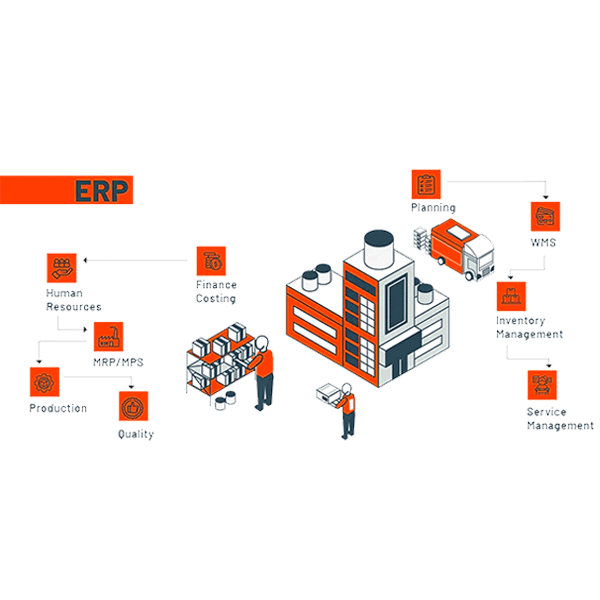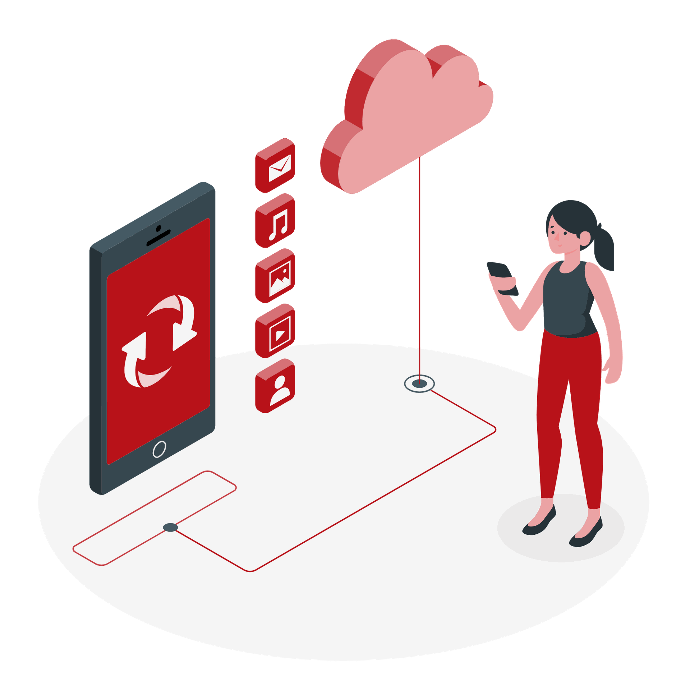An ERP system is more than just software: it’s the engine driving your growth, optimizing every aspect of your business. In a market flooded with options, one key question arises: horizontal or vertical ERP? One offers flexibility and adaptability across all industries, while the other excels in precision, tailored to the needs of a single sector.
Choosing the right ERP is no small decision: it lays the foundation for your future success. What are your priorities? Which direction do you want to take? Discover how to select the ERP that will become your greatest asset. Don't miss the opportunity to make the strategic choice that will transform your business!
What is a horizontal or generalist ERP ?
Definition and key characteristics
A horizontal ERP, also known as a generalist or cross-industry ERP, is an extremely adaptable management solution. Unlike other ERP systems that focus on specific industries, a horizontal ERP is designed to be versatile, easily integrating into a wide range of business sectors. It offers a comprehensive array of features, including sales management, accounting, and CRM.
For instance, OdooFor instance, Odoo stands out as a horizontal ERP by providing remarkable flexibility through its numerous modules, which cover a vast variety of business processes.

Advantages of horizontal ERPs
- Flexibility: These ERPs are designed to adapt to various industries, allowing you to manage your business processes in a customized way, regardless of your field.
- Versatility: As an all-in-one solution, horizontal ERPs address a broad range of business needs while being capable of evolving alongside your company.
- Lower initial cost: Often offered as SaaS solutions, these ERPs require a lower initial investment, making the technology accessible to a larger number of businesses.
Challenges of Horizontal ERPs
- Necessary customization: Adapting a horizontal ERP to meet specific requirements may involve adjustments that can be costly and time-consuming.
- Additional costs: Although the initial cost is low, the expenses for customizing the ERP to address industry-specific needs can increase. However, these investments typically pay off due to the ERP’s ability to evolve and adapt to your business. At Captivea, we even view the integration of a business management system as a potential return on investment!
If you want to learn more about the costs and benefits of an ERP solution like Odoo, check out our detailed article here.
What is a vertical or industry-specific ERP?
Definition and key characteristics
Vertical ERPs, also known as industry-specific ERPs, are software solutions designed specifically for sectors such as healthcare, manufacturing, or logistics. Unlike horizontal ERPs, these systems provide tools tailored directly to the business processes of each industry, allowing for quicker implementation but often less flexibility.
This means that businesses receive software with features that are specifically suited to their field of activity.

Advantages of horizontal ERPs
- Industry-specific focus: Vertical ERPs are designed to meet the precise needs of a particular sector. For instance, an ERP tailored for the pharmaceutical industry will include specialized tools for managing clinical trials and adhering to strict industry regulations. This specialization allows businesses to benefit from a system that is perfectly suited to the unique challenges of their field.
- Built-in features: These systems come with features that are already aligned with the business processes of the company. This greatly facilitates implementation, as the tools are designed to directly fit the practices of the industry, reducing the need for additional customization.
- Compliance: Vertical ERPs adhere to the standards and regulations specific to their sector. This built-in compliance helps businesses meet legal and industry requirements without the need for major modifications.
Limitations of vertical ERPs
While vertical ERPs offer advanced specialization that can perfectly meet the needs of a specific sector, they also come with notable limitations. Here’s an overview of the main constraints associated with these solutions:
- Higher initial cost: Acquiring and implementing a vertical ERP typically involves a significant financial investment. The specialization of these systems often translates to higher costs compared to more general solutions. This elevated cost can be a major hurdle for businesses, especially those in the startup phase or small enterprises.
- Sector-specific dependence: The strong specialization of vertical ERPs can limit a company's flexibility if it wishes to diversify its activities or shift to a different sector. Their design for a specific field can make it challenging to adapt to new markets or strategic changes, potentially hindering the company's evolution.
- Migration complexity: Transitioning to a different system after integrating a vertical ERP can be particularly complex and costly. Data is often stored in proprietary formats, and specific integrations are tightly coupled, making it challenging to transfer information to a new system. This dependency on the vendor can also reduce flexibility regarding maintenance and support.
Decision factors for choosing an ERP
Company needs: size, industry, internal processes
When considering the adoption of an ERP system, evaluating your company's needs is crucial. Factors such as the size of your company, your industry, and your internal processes play a decisive role in selecting the ideal solution. For instance, a large manufacturing enterprise with complex processes might benefit from a vertical ERP tailored to the manufacturing industry, offering specialized features to optimize the production chain. On the other hand, a growing SME might prefer a horizontal ERP like Odoo, which provides flexibility and modularity to accommodate a range of needs while being more cost-effective.

Growth and scalability of the business
Scalability is another crucial aspect. Your ERP must be able to grow with your business. Horizontal ERPs are typically more adaptable to changes, allowing for the addition of modules as your needs evolve. If you anticipate expansion or diversification, a flexible ERP might be a better choice. However, while vertical ERPs excel in their specific field, they may have limitations if you venture into new sectors.

Required customization level and compliance
The required level of customization is also a crucial factor. Horizontal ERPs often provide a wide range of customization options to meet the diverse needs of businesses. However, this can require a significant investment of time and resources to tailor the system to your specific needs. Vertical ERPs, on the other hand, come with features already tailored to the regulatory and operational requirements of your sector, offering immediate compliance but with less flexibility for other needs.

User experience and usability
User experience is a critical, yet often underestimated, factor. An ERP system must be intuitive and easy to use to ensure successful adoption within your company. Horizontal ERPs, such as Odoo, are renowned for their user-friendly interface and ease of use. Conversely, vertical ERPs, while specialized, may sometimes present a steeper learning curve due to their sector-specific complexity.

Support and maintenance
Support and maintenance are crucial for the longevity of your ERP system. Horizontal ERPs, due to their popularity among a broad user base, often benefit from extensive technical support and regular updates, making long-term management easier. In contrast, vertical ERPs may require more specialized technical support, which can sometimes be less accessible. Therefore, it's essential to evaluate the available support options and the quality of assistance offered before committing, as this will significantly impact the day-to-day management and lifespan of your system.

Functional coverage
Finally, the functional coverage of the ERP must align with your specific needs. A horizontal ERP like Odoo provides a wide range of modules that can cover various aspects of business operations. In contrast, a vertical ERP is designed to offer in-depth functional coverage within a specific domain, which can be advantageous if your needs are highly specialized.

ERP Saas
SaaS ERP (Software as a Service) represents an appealing alternative, providing ERP solutions that are accessible online without the need for complex IT infrastructure. These systems are often more flexible and can lower implementation costs. They are available on-demand, which can be particularly advantageous for businesses seeking a scalable solution that is accessible at any time.

Budget and total cost of ownership (TCO)
Budget is a decisive factor in choosing an ERP system. Beyond the initial purchase cost, it is crucial to consider the total cost of ownership (TCO), which includes implementation, maintenance, and updates. Vertical ERPs, while often more expensive upfront, may provide turnkey solutions with specific features, potentially reducing customization costs. On the other hand, horizontal ERPs, with their broader customization options, may require additional investments to tailor functionalities to your needs.

Conclusion
Choosing between a horizontal and vertical ERP system is more than just a technology decision, it's a strategic one. Horizontal ERPs offer flexibility and adaptability, making them ideal for growing businesses. In contrast, vertical ERPs provide tailored solutions designed to meet the specific needs of a given industry.
To make the right choice, ask yourself the crucial questions: What are your objectives? What is your budget? How do you foresee your company's evolution?
Take the time to analyze your priorities to select the ERP that will truly make a difference and help you achieve your growth goals!






